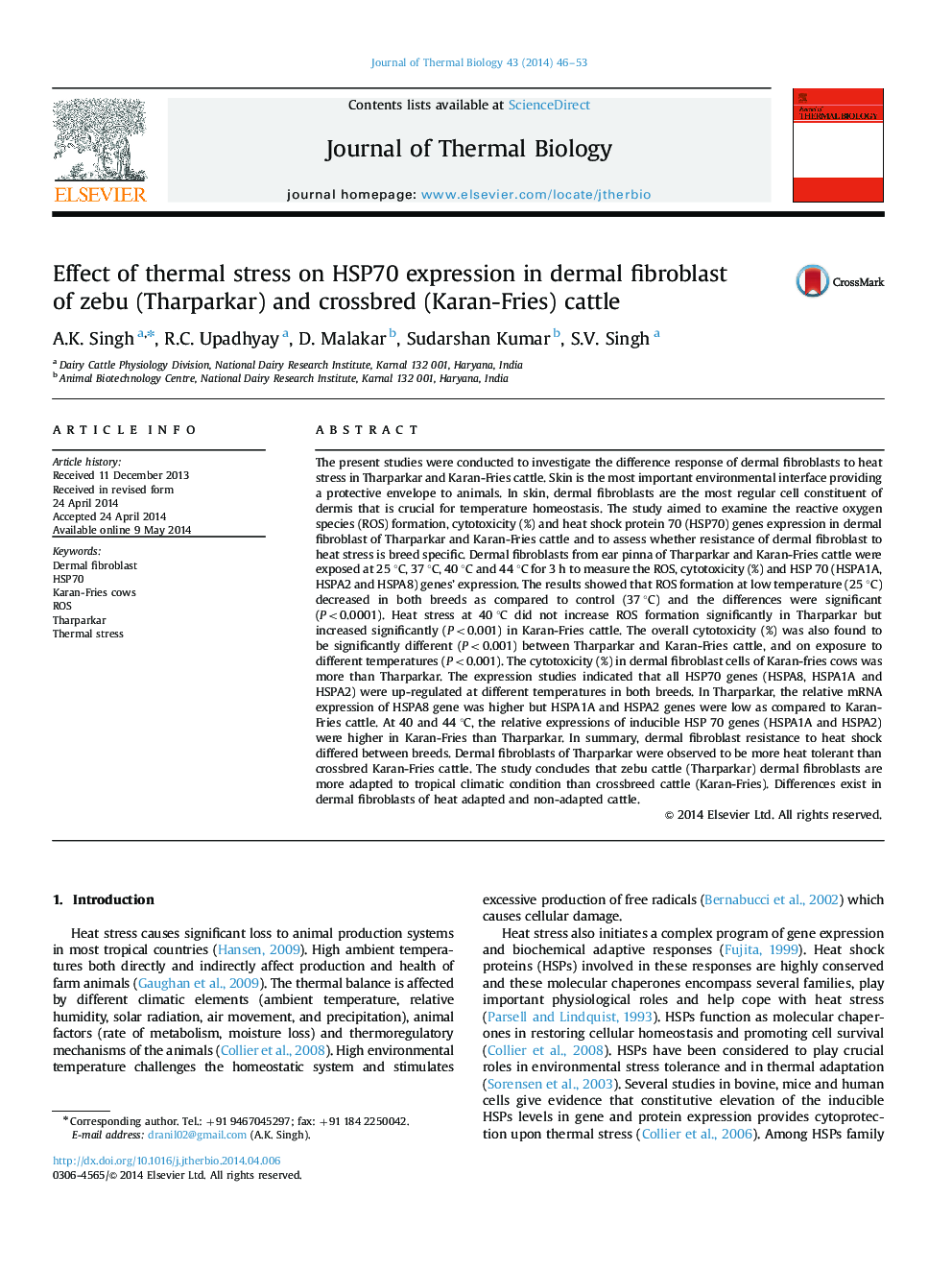| کد مقاله | کد نشریه | سال انتشار | مقاله انگلیسی | نسخه تمام متن |
|---|---|---|---|---|
| 2842965 | 1571102 | 2014 | 8 صفحه PDF | دانلود رایگان |

• Dermal fibroblasts resistance to heat stress was assessed in zebu and crossbred cattle.
• Oxidative stress and cytotoxicity were lower in Tharparkar than Karan-Fries cattle.
• Expression of HSPA8 gene was higher, but that of HSPA1A and HSPA2 was lower in Tharparkar than Karan-Fries.
• Dermal fibroblasts of zebu cattle are more adapted to tropical climatic condition than crossbred cattle.
The present studies were conducted to investigate the difference response of dermal fibroblasts to heat stress in Tharparkar and Karan-Fries cattle. Skin is the most important environmental interface providing a protective envelope to animals. In skin, dermal fibroblasts are the most regular cell constituent of dermis that is crucial for temperature homeostasis. The study aimed to examine the reactive oxygen species (ROS) formation, cytotoxicity (%) and heat shock protein 70 (HSP70) genes expression in dermal fibroblast of Tharparkar and Karan-Fries cattle and to assess whether resistance of dermal fibroblast to heat stress is breed specific. Dermal fibroblasts from ear pinna of Tharparkar and Karan-Fries cattle were exposed at 25 °C, 37 °C, 40 °C and 44 °C for 3 h to measure the ROS, cytotoxicity (%) and HSP 70 (HSPA1A, HSPA2 and HSPA8) genes’ expression. The results showed that ROS formation at low temperature (25 °C) decreased in both breeds as compared to control (37 °C) and the differences were significant (P<0.0001). Heat stress at 40 °C did not increase ROS formation significantly in Tharparkar but increased significantly (P<0.001) in Karan-Fries cattle. The overall cytotoxicity (%) was also found to be significantly different (P<0.001) between Tharparkar and Karan-Fries cattle, and on exposure to different temperatures (P<0.001). The cytotoxicity (%) in dermal fibroblast cells of Karan-fries cows was more than Tharparkar. The expression studies indicated that all HSP70 genes (HSPA8, HSPA1A and HSPA2) were up-regulated at different temperatures in both breeds. In Tharparkar, the relative mRNA expression of HSPA8 gene was higher but HSPA1A and HSPA2 genes were low as compared to Karan-Fries cattle. At 40 and 44 °C, the relative expressions of inducible HSP 70 genes (HSPA1A and HSPA2) were higher in Karan-Fries than Tharparkar. In summary, dermal fibroblast resistance to heat shock differed between breeds. Dermal fibroblasts of Tharparkar were observed to be more heat tolerant than crossbred Karan-Fries cattle. The study concludes that zebu cattle (Tharparkar) dermal fibroblasts are more adapted to tropical climatic condition than crossbreed cattle (Karan-Fries). Differences exist in dermal fibroblasts of heat adapted and non-adapted cattle.
Journal: Journal of Thermal Biology - Volume 43, July 2014, Pages 46–53